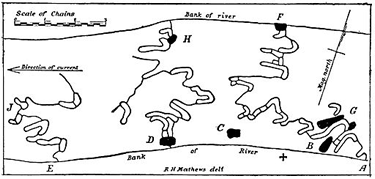Managing resources
Managing aquatic and terrestrial resources
Aboriginal and Torres Strait Islander knowledge has been used to address many modern aquatic and terrestrial resource management issues.
|
Indigenous Protected Areas
Indigenous Protected Areas1 (IPA) allow the traditional owners of the land to protect their sacred sites, landscapes and flora and fauna. |
Brewarrina fish traps
The Brewarrina fish traps are a well-documented example of how Aboriginal people have cooperatively managed resources in the Darling River at Brewarrina. Public domain. Robert Hamilton Mathews, an early Australian surveyor and anthropologist, drew this map of the Brewarrina fish traps in 1907. |
|
Brewarrina Ngemba Billabong The rivers, lakes and floodplains of the Brewarrina Ngemba Billabong3 (.pdf 606kB) on the Barwon River were declared an IPA in 2010. For almost 100 years this land had been the site of the Brewarrina Aboriginal Mission, used to house local Aboriginal people whose land was taken for grazing. It is currently used to train young people in land management and will eventually be developed into a recreational area for all to share. Watch Diane Kelly reflect on her life on the Barwon River. |
Saving sea turtles Watch how the conservation of sea turtles is managed in Mapoon Aboriginal community, Cape York Peninsula. A Sea Country Plan shows Indigenous knowledge and modern science working together4 to help conserve and manage sea turtles in east Arnhem Land. |
Links
- http://www.environment.gov.au/indigenous/ipa/index.html
- http://commons.wikimedia.org/wiki/File:Notes_on_the_Aborigines_of_New_South_Wales_-_Plate_10_Plan_of_the_Ngunnhu_or_Native_Fish_Traps.jpg
- http://www.environment.gov.au/indigenous/ipa/pubs/brewarrina.pdf
- http://livingknowledge.anu.edu.au/learningsites/seacountry/12_workingtogether.htm


